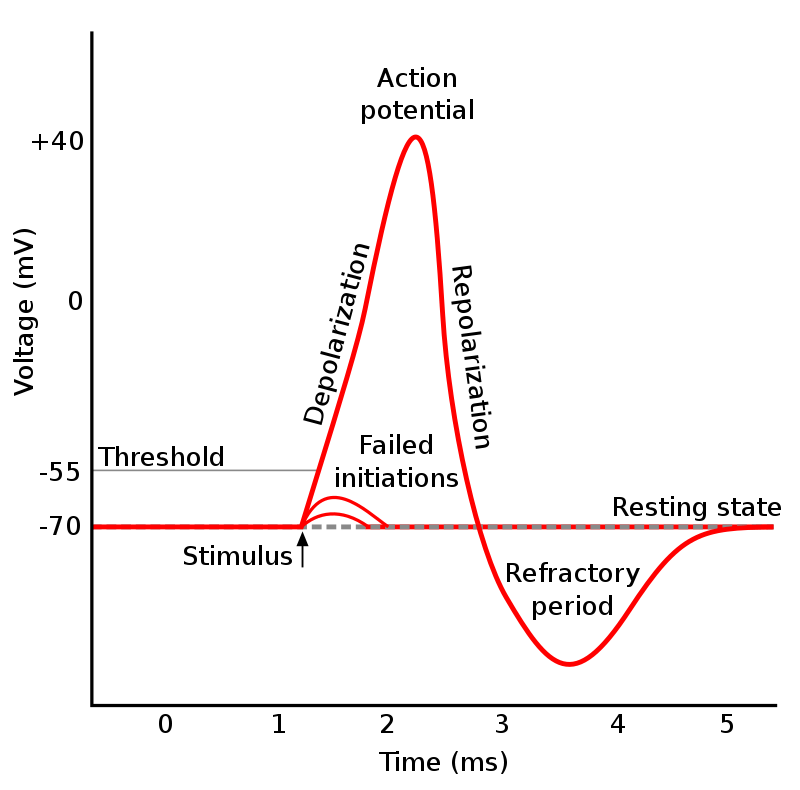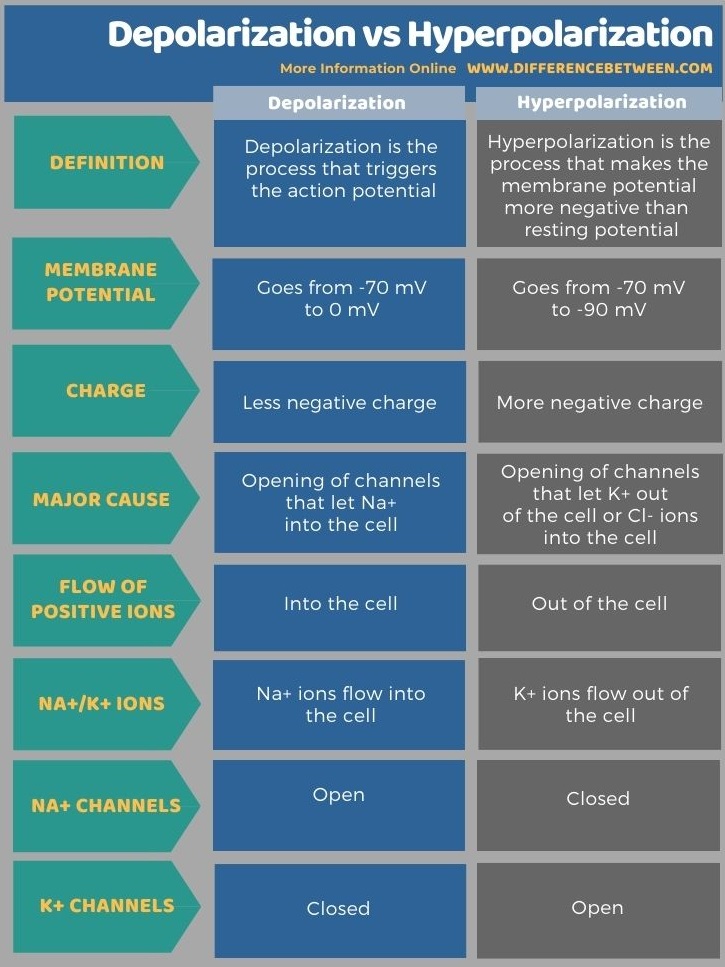Difference Between Depolarization and Hyperpolarization
The key difference between depolarization and hyperpolarization is that in depolarization, sodium channels open up, letting Na+ ions flow inside the cell, making membrane potential less negative, while in hyperpolarization, excess potassium channels open up, letting K+ ions to flow out the cell, making membrane potential more negative than the resting potential.
Action potential is the mode by which neurons send electrical signals. It occurs when a neuron sends information along an axon away from the cell body. There are three main stages in action potential. They are depolarization, repolarization and hyperpolarization. Depolarization triggers an action potential. Depolarization occurs when the inside of the cell becomes less negative. Na+ channels open up and allow Na+ ions to go inside the cell, making it less negative. Therefore, the membrane potential goes from -70 mV to 0 mV in depolarization. Hyperpolarization occurs when the inside of the cell becomes more negative even than the original resting potential. It occurs as a result of opening K+ channels, allowing more K+ ions to flow out of the cell. Membrane potential goes from -70 mV to -90 mV in hyperpolarization.
CONTENTS
1. Overview and Key Difference
2. What is Depolarization
3. What is Hyperpolarization
4. Similarities Between Depolarization and Hyperpolarization
5. Side by Side Comparison – Depolarization vs Hyperpolarization in Tabular Form
6. Summary
What is Depolarization?
Depolarization is the process that triggers an action potential. Depolarization increases the membrane potential and makes it less negative. Then the membrane potential passes the threshold value of -55 mV. At the threshold values, sodium channels open up and allow sodium ions to flow inside the cell. The inflow of sodium ions makes the membrane potential more positive and reach up to +40 mV firing an action potential. Depolarization is the rising phase of membrane potential. Generally, it goes from -70 mV to +40 mV.

Figure 01: Action Potential in a Neuron
When the membrane potential reaches the peak action potential, the sodium channels inactivate themselves, stopping the influx of sodium ions. Then the repolarization or the falling phase begins. Potassium channels open up, allowing potassium ions to flow out of the cell. Eventually, membrane potential comes back to the normal resting potential.
What is Hyperpolarization?
Hyperpolarization is the event that makes the membrane potential more negative than the resting potential. This occurs as a result of excess potassium channels remaining opened. In other words, hyperpolarization happens as a result of potassium channels staying open a little longer than needed. This leads to excessive potassium efflux from the cell. Membrane potential goes from -70 mV to -90 mV due to hyperpolarization. However, after some time, potassium channels close, and the membrane potential stabilizes at resting potential. Moreover, sodium channels return to their normal state.
What are the Similarities Between Depolarization and Hyperpolarization?
- Hyperpolarization is the opposite process of depolarization.
- Both occur when ion channels in the membrane open or close.
- They produce a graded potential.
What is the Difference Between Depolarization and Hyperpolarization?
Depolarization makes the membrane potential less, negative triggering the action potential, while hyperpolarization makes membrane potential more negative than the resting potential. So, this is the key difference between depolarization and hyperpolarization.
The below infographic lists more differences between depolarization and hyperpolarization.

Summary – Depolarization vs Hyperpolarization
Depolarization and hyperpolarization are two stages of membrane potential. In depolarization, the membrane potential is less negative, while in hyperpolarization, the membrane potential is more negative, even than the resting potential. Moreover, depolarization takes place due to the influx of sodium ions into the cell, while hyperpolarization takes place due to the excessive potassium efflux from the cell. In depolarization, sodium channels open up, while in hyperpolarization, potassium channels remain open. Thus, this summarizes the difference between depolarization and hyperpolarization.
Reference:
“Depolarization, Hyperpolarization & Neuron Action Potentials (Article).” Khan Academy, Available here.
“Depolarization.” Wikipedia, Wikimedia Foundation, 8 Feb. 2021, Available here.
Image Courtesy:
1. “Action potential” By Original by en:User:Chris 73, updated by en:User:Diberri, converted to SVG by tiZom – Own work (CC BY-SA 3.0) via Commons Wikimedia
ncG1vNJzZmivp6x7pbXFn5yrnZ6YsqOx07CcnqZemLyue8OinZ%2Bdopq7pLGMm5ytr5Wau26wxKmmpZminseiwMiopWaZnpl6qcXPnqmpp5yWv6rGwK2gqKZf